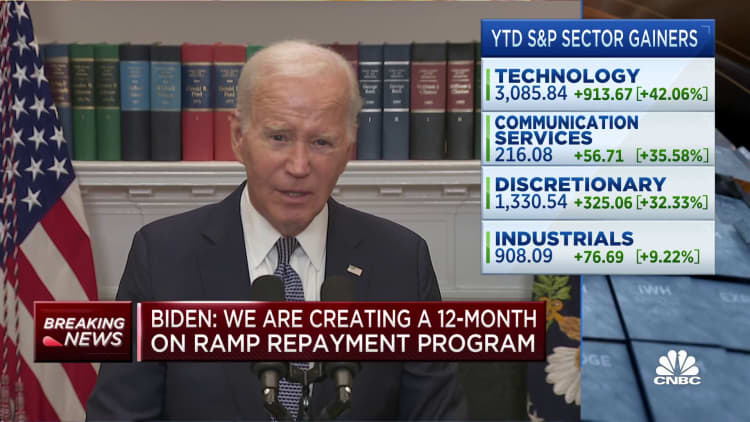The Biden administration recently announced it would look to forgive the student debt of borrowers experiencing "financial hardship."
So, who might be eligible?
It's still uncertain, but there are clues from the U.S. Department of Education and in other programs that aim to help the same group of borrowers.
Since the Supreme Court struck down President Joe Biden's original plan to cancel up to $400 billion in student debt, his administration has tried to rework its relief package to make it legally viable. To do so, it has sought to narrow the aid by focusing on certain groups, including those with balances greater than what they originally borrowed and students from schools of questionable quality.
More from Personal Finance:
How one beach city is helping residents age in place
What happens to your Social Security benefits when you die
62% of adults 50 and over have not used professional help for retirement
The U.S. Department of Education now says it will hold an additional rulemaking session on its "Plan B" for student loan forgiveness on Feb. 22 and 23, during which the negotiators will focus exclusively on financially strapped borrowers.
That category may be challenging to define.
But the department is looking for ways for people to get their debt forgiven based on hardship that remains after other benefits are exhausted, according to a source familiar with its plans.
Here's who might be eligible.
Bankruptcy eligibility could be a guide
The Education Department has signaled that it could turn to the standard for the discharge of student loans in bankruptcy for guidance in how it defines those eligible for forgiveness under the hardship provision.

To walk away from their student debt in bankruptcy, borrowers typically have to prove "undue hardship," which contains three factors: 1) an inability to maintain a minimal standard of living, 2) an unlikeliness to see their financial situation change and, 3) a record of good faith efforts to repay their loans.
"These standards may be informative of the considerations other policymakers have used to identify hardship," the department wrote in a recent issue paper.
Few borrowers are likely to meet these requirements, said higher education expert Mark Kantrowitz: "Bankruptcy discharge of student loans requires a very harsh standard."
Department wants to use government data
The negotiators on the committee for Biden's revised relief program have identified several categories that could signal hardship. Those include borrowers who received a Pell Grant or qualified for a health insurance subsidy on the Affordable Care Act's marketplace.
Lawmakers have also pushed the department to consider borrowers' student debt-to-income ratio, as well as those debtors over a certain age with limited income.
One wrinkle: The Education Department has suggested it wants to identify eligible borrowers through easily obtainable administrative records. As a result, certain struggles, including significant medical or child-care expenses, may be hard for it to capture.
"They much prefer options that can be implemented using data already available to them," Kantrowitz said.
Currently, the department can access records from the U.S. Department of Veterans Affairs and the Social Security Administration. These agencies could potentially help it find certain borrowers with disabilities and or those living in poverty. Its own data could be used to identify borrowers who received a Pell Grant.
More than 90% of Pell Grant recipients in 2015-2016 came from families with household incomes below $60,000, according to Kantrowitz. More than 6 million undergraduate students received the grants in 2020.
The Education Department could possibly get data from the U.S. Department of Health and Human Services to identify those who've received a health-care subsidy, Kantrowitz said.
More relief for struggling borrowers could be on the way
Meanwhile, the government's collection practices with student loan borrowers, including the garnishment of wages and Social Security benefits, is another area under review, according to the source familiar with its plans. Consumer advocates have said these measures are extreme and punish people already struggling.
The Education Department has also recently made it easier for struggling borrowers to get their student loans erased in bankruptcy court. Previously, it was difficult, if not impossible, for people to part with their education debt in a normal bankruptcy proceeding.
Don't miss these stories from CNBC PRO:
- Forget 'FANG' and 'Magnificent 7,' the new hot portfolio is 'MnM,' says Raymond James
- Walmart just split its stock. History shows what will happen next with the megacap
- Alibaba, ASML and more: Jefferies reveals its 'highest-conviction' stocks to buy — and one has 118% upside
- Tesla is one of the most oversold stocks in the S&P 500 and could be due for a bounce


